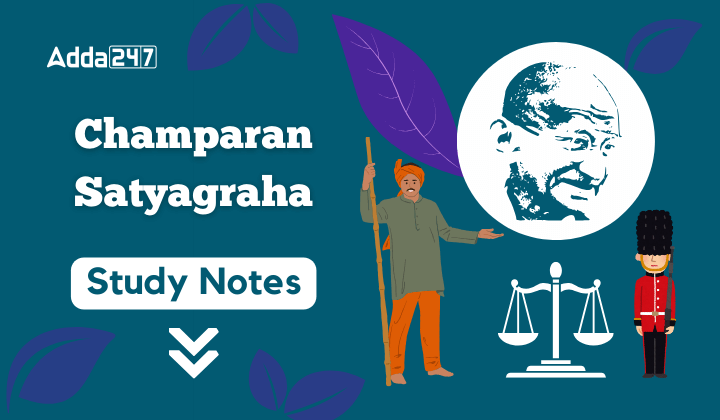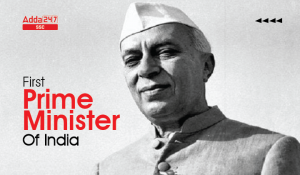Champaran Satyagraha 1917
The Champaran Satyagraha was the first ever Satyagraha (Non-Violent Resistance) on Indian soil led against the injustices of the British Government in India. It was led by Mohandas Karamchand Gandhi (Mahatma Gandhi) after his experiments with Satyagraha during his stay in South Africa. The Champaran Satyagraha which began as a farmer’s uprising against Indigo cultivation ultimately became a historically important movement in the Indian Freedom Struggle.
This article discusses how the Champaran Satyagraha unfolded in the Champaran District of Bihar. These notes on Champaran Satyagraha should help you in your upcoming competitive examinations for solving Modern History – General Knowledge questions.
Background: Indigo Plantation
Indigo and its Importance during Colonial Rule:
- The Indian farmers’ struggle started with the issue of Indigo Plantation.
- Indigo is a natural dye that is made from the leaves of a plant called Indigofera.
- Indigo was a valuable commodity and its demand rose highly across Britain and Europe, especially in the textile industry (e.g. dying of Jeans).
- Indigo-dyed denims’ popularity skyrocketed during the British Colonial Era making it a profitable business.
Reasons for Transferring Indigo Cultivation to India:
- The British East India Company (EIC) wanted to turn the Indigo production into a stable source of profit.
- They pressured the poor Indian farmers through various means into shifting from sustainable agricultural practices of growing edible crops to growing cash crops like Indigo.
- The Indigo produced had little to no value in Indian markets which forced the farmers to sell their produce at unfairly low prices to the British.
- The profitability of this business caused the British EIC to adopt the Tinkathia System further marginalizing the Indian farmers.
Causes Leading to Champaran Satyagraha
Tinkathia System
- The Tinkathia System was EIC’s policy introduced for the economic exploitation of Indian farmers.
- The Tinkathia System was mainly implemented in the Eastern Regions of India especially Bihar.
- Tinkathia or Teen Kathia as the name suggests means three Katha which is a unit of measurement of land. One Bigha equals 20 Katha.
- Under the Tinkathia System, 3 out of every twenty Katha of land owned by the farmers must be cultivated with Indigo.
- The farmers are not allowed to grow any other crop despite the loss faced by them nor sell the indigo produced to anyone else except the British EIC.
Decline of Indigo:
- With the invention of European synthetic indigo, the demand for natural indigo went down.
- This caused the companies buying indigo to cancel their contracts and exploit the farmers further by imposing further debt to free them from the Tinkathia System.
Oppression and Discontent:
- The British took advantage of the farmers’ conditions as they were not able to sell their standing Indigo produce.
- They exploited the farmers into signing contracts, debt, and bonds with a promise to free them of the Tinkathia System while charging a high-interest rate of 12%.
- The oppressing conditions led the farmers to dissent against the landholders and the British EIC with the help of Mahatma Gandhi and other local leaders.
The First Satyagraha by Gandhiji
Arrival of Gandhi in Champaran, Bihar
- Gandhiji returned from South Africa on 9 January 1915 where he had already begun forming his unique method of protest against oppressive government policies i.e. Satyagraha or Non-Violent Movement.
- MK Gandhi met Raj Kumar Shukla in the Lucknow session of the Indian National Congress in 1916.
- Upon his insistence, on 15 April 1917, Gandhiji arrived in East Champaran, Bihar to see the plight of the people oppressed by the Indigo Plantation rules.
- Gandhiji met many affected farmers, listened to their grievances, and decided he could not leave without helping them.
The Champaran Satyagraha (10 April – May 1917)
- Gandhiji started gathering the evidence from the first day as he talked to farmers regarding injustice and exploitation.
- The British authorities opposed his presence and directed him to leave Champaran immediately.
- Gandhiji refused to comply even with the threat of being arrested in the case of civil disobedience.
- Masses were attracted by Gandhiji’s personality and his attention to farmers’ problems.
- This led the people of Champaran to support Gandhiji and organize mass protests across the district.
- Many mass gatherings, protests, hunger strikes, etc. followed as a part of the Non-Violent movement against the Tinkathia System and peasants’ oppression.
- Important Leaders included Mahatma Gandhi, Brajkishore Prasad, Rajendra Prasad, Mazhar-ul-Haq, J.B. Kripalani, Anugrah Narayan Singh, Ramnavami Prasad, and many others
- In the end, the British Government was convinced there was no way out other than a compromise with Gandhiji.
- This led to partial acceptance of farmers’ demands.
- After a thorough investigation by an inquiry committee, the Champaran Agrarian Act of 1918 was passed to solve the issue.
Impact of Champaran Satyagraha on Indian National Movement (INM)
- This was the beginning of Gandhi’s charismatic leadership in the Indian Freedom Struggle.
- The non-violent Satyagraha and Civil Disobedience were proven as effective and powerful measures against oppressive British rule.
- The first Satyagraha of Modern Indian History paved the way for further movements in India such as the Civil Disobedience Movement, Non-Cooperation Movement, Quit India Movement, etc.
- It was the first time that the power of mass movement and inclusion of the masses was recognised as opposed to the elite ruling class or separate factions fighting for their specific reasons against British rule.
Summary
Here is a summary of Champaran Satyagraha to consolidate your learning from this article.
| Champaran Satyagraha Summary | |
| Date | 10 April – May 1917 |
| Location | Champaran, Bihar |
| Associated Leaders | Mahatma Gandhi, Brajkishore Prasad, Rajendra Prasad, Mazhar-ul-Haq, J.B. Kripalani, Anugrah Narayan Singh, Ramnavami Prasad, and others |
| Cause | Exploitative Indigo Plantation or Tinkathia System impose on farmers |
| Method | Satyagraha (Non-Violent Movement); Mass Mobilization |
| Outcome | Champaran Agrarian Act in 1918; Awareness about farmers’ rights; Inspired Indian Freedom Struggle |
| Importance | First Satyagraha of India |



 Reasoning Topics Asked in SSC CGL Exam L...
Reasoning Topics Asked in SSC CGL Exam L...
 Free Study Material for SSC CGL 2025, Do...
Free Study Material for SSC CGL 2025, Do...
 Pandit Jawaharlal Nehru, First Prime Min...
Pandit Jawaharlal Nehru, First Prime Min...


